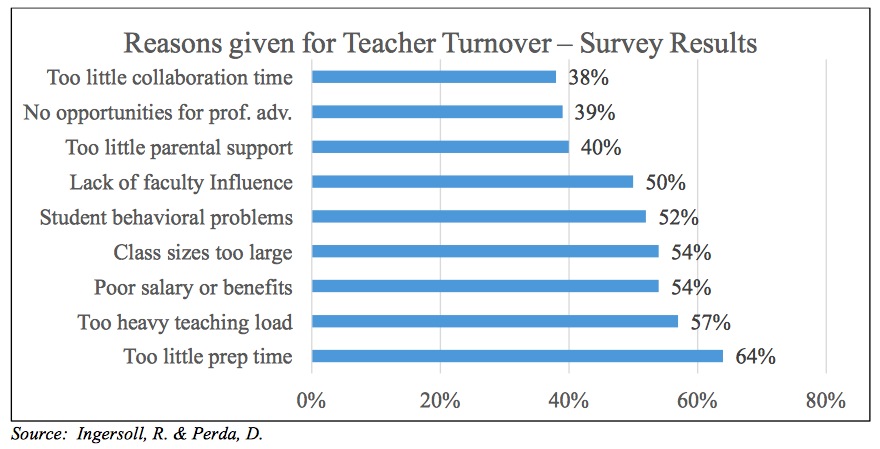Senator Jeff Monroe (R-24/Pierre) continues to make stuff up to excuse his resistance to the Blue Ribbon K-12 panel’s teacher pay proposal.

At the Stanley County School Board meeting in November, Senator Monroe rambled through the usual excuses for taking no action to address South Dakota’s teacher shortage by raising teacher pay—South Dakota’s lowest in the country in everything else, other factors besides pay drive workers away from South Dakota, blah blah blah. Monday, Senator Monroe told the Pierre School Board that he’s “not a tax guy, so you know where I sit there, but I don’t have a big problem with doing something.” The Senator then says something about a “survey of all the teachers” at the last part of the Blue Ribbon report that “had about fifteen reasons why the teachers weren’t coming or were leaving, and if you look at that list, it’s not really related to money.”
I’ve read the Blue Ribbon K-12 panel’s final report multiple times. Page 13 of the 34-page document offers this summary of Dr. Richard Ingersoll’s survey of reasons for teacher turnover. “The survey data is nationwide,” the report says, “and the task force acknowledged that low salaries are probably a more significant factor in South Dakota. Unfortunately, no similar data exists that is specific to South Dakota.”
Right there, in plain text, the Blue Ribbon final report rebuts Senator Monroe’s assertion that money isn’t related to South Dakota’s teacher shortage. The Ingersoll survey is not South Dakota-specific and thus should not serve as the basis for Monroe’s South Dakota policymaking.
Even if we overlook the non-South Dakota-specificity of the Ingersoll data, it still supports the ugly conclusion Senator Monroe is trying to avoid: more money could directly address the leading reasons for teacher turnover.

Poor salary and benefits are the third biggest reason teachers leave the job. More money is the direct solution.
The other three items atop the Ingersoll survey are all directly related to money as well. Give schools more money for teacher pay, and they can fill vacancies, hire more teachers, and thus give each teacher a little more prep time, a less heavy teaching load, and smaller class sizes. That route may hire more teachers and not raise the average pay for every teacher, and that’s a different policy route from the Blue Ribboneers’ stated goal of raising average teacher pay by 20%, but it’s still a solution that boils down to money.
If Senator Monroe doesn’t think South Dakota teachers deserve higher pay, and if he doesn’t want to do anything about the teacher shortage, he should just say so.
*****
At the same meeting, Rep. Tim Rounds (R-24/Pierre) said he thinks it may be hard to convince the Legislature to raise taxes again, especially in an election year. Rep. Mary Duvall (R-24/Pierre) acknowledges that a lot of people are coming up to her and saying they’ll swallow a sales tax increase if the Legislature can guarantee the money goes to teachers. According to KCCR, Duvall, Rounds, and Monroe all said they are “looking forward to Governor Daugaard’s State of the State Speech, to see what his specific recommendations will be.”
Real leaders wouldn’t be waiting for the Governor’s recommendations. They would talk less about how hard it might be to persuade the Legislature and say that, as legislators themselves, they are ready to put forward a plan and fight for it. Rep. Lee Schoenbeck (R-5/Watertown) did that this summer. Rep. Lance Russell (R-30/Hot Springs) did that last week. Apparently such bold leadership is not expected of legislators from the Governor’s district.
Monroe isn’t the sharpest knife in the drawer is he? Neither is Tim Rounds. Must run in the family
I wonder if Mr. Monroe would support a plan put forth during this next speech about cutting down on how many teachers there are in each school and just splitting the students up, freeing up more money to pay the remaining teachers more? That does not raise taxes. I wonder if the Governor will propose that because I get the sense there are many like Mr. Monroe who would like it.
Monroe’s addition to the SoDak Senate brought the aggregate IQ thereof up from 70 to 72.
As for Tim Rounds…, well, he IS a Rounds.
Do not look for the leadership from Pierre. They are bankrupt on selling.
“Real leaders wouldn’t be waiting for the Governor’s recommendations.”…
Tragic and True.
The GOP has dumbed themselves down and bitten the fruit of power and greed to make the job description of legislators as just place holders who are subservient to the Governor’s unelected son-in-law and the Party.
Too harsh?
My prediction remains as it has in the past. The legislature will water-down the qualifications for who can substitute for a classroom teacher including terms like facilitator, monitor, teacher-assistant, educational-aide, etc. They will allow schools to pay minimum wage to have someone over 18 in the classroom (preferably someone with a carry permit).
People like Monroe make me Happy that my kid makes double as a teacher out of State in a second year.
My god…what an idiot he is. And Pierre keeps electing him.
Here is an idea….have the medical providers in SD pay for the State’s share of Medicaid Expansion. After all, they are the bottom line financial recipients of the $250M + in payments that they haven’t received in the past…then use Cheap Grandpa’s new found revenue by buying down Regent debt of $67M or so and put it into education/educators salaries.
What medical provider wouldn’t take $.75 on a dollar of now uncompensated care that they will get paid for under Medicaid Expansion? I know, killing two birds with one stone is dum…sorry…nevermind.
Mr. Bender, I do not think those Regent fellows will let their money go to the good teachers of the world when they want it to go to their teachers. I’m just sayin…
Not every Republican is taking Monroe’s anti-progress view. Says Rep. Mike Stevens, District 18 Republican (from a link Mr. Kurtz submitted under another thread):
This is a case where the Republican mainstream is going to have to get together with the Democrats to build a majority for teacher increases against the hard-right wing Monroe represents. (But then how does Russell fit into that picture with his support of the $75 million but insistence that it come from existing video lottery revenues?).
So, I’m assuming Mr. Monroe does his chiropractic services for free? Or at the very least, minimum wage?
Seriously, who expects leadership from the legislature? This is the same group of sheep who, when GDD said he was cutting education 10%, said “Okay” and went gamboling on.
I believe most chiropractors do pro-bonus work.
This point is still one of the elements of the BRTF that gave me pause when first presented by Dr. Ingersoll. Cory, you are on the money that these are national trends and not the specific picture SD faces (and we can speculate how lowest salaries in SD changes the rankings of this data all day). More I hope that the message from the BRTF deeper discussion (yes, we did more than passively look at data) is that of the nine elements listed, six directly relate to problems exacerbated by a teacher shortage (which we did conclude is worsened by low wages). When districts are short on quality teachers, they put added stress on faculty so that opportunity loss is minimized for our students. Teachers are loaded with extra classes (sometimes in areas they would prefer not to teach) which means less time during the day to prepare and work on feedback for students’ work; class sizes are increased because teachers cannot be found to fill positions (grudznick’s solution/fear from above); professional development and collaboration suffer because more and more teacher time has to be spent in front of students. Teaching is far more than “the show” we do in front of class. In elementary where specials like art, music , and PE continue to be cut for budget reasons, the stress on the elementary teacher grows.
I would even argue the three remaining “non-money” reasons would also improve given a professional recognition of time needed to deal with those issues in the current social-educational climate: time that is only available through increasing funding for staffing.
The BRTF certainly saw that “poor salary and benefits” was not the only “money” issue on the list. The first task of the force was to establish the truth about the problem and dispel the myths and misconceptions.
O, how involved will BRTF members be in testifying and lobbying for the teacher pay proposal? It would seem the 26 people involved in that process ought to each get 5 legislators to talk to extensively during the Session, if not right now in pre-Session briefings.